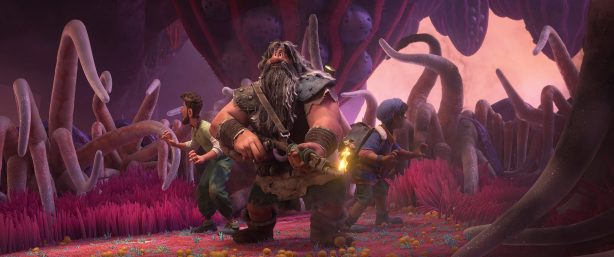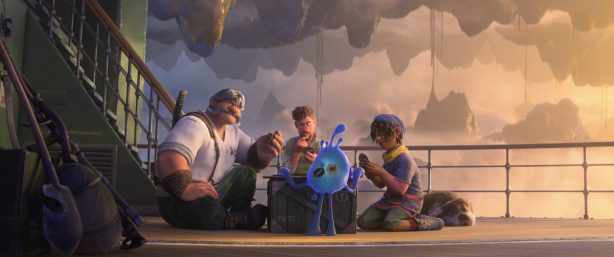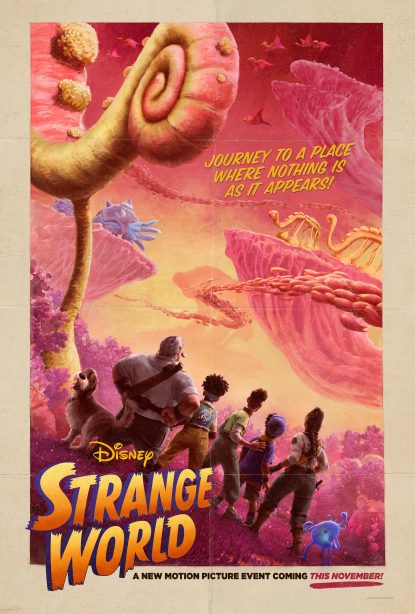The breathtaking settings for Walt Disney Animation Studios’ Strange World, debuting exclusively in theaters today, invite viewers to a place beyond their wildest imagination.
The 61st feature from Disney Animation is set in a vast, hidden, subterranean world where bizarre creatures, looming danger, and points unknown await a legendary family of explorers, the Clades, as they navigate the uncharted, treacherous land alongside a motley crew that includes a mischievous blob, a three-legged dog, and a slew of ravenous creatures.
Helmed by Oscar®-winning director Don Hall (Big Hero 6, Raya and the Last Dragon) and co-director/writer Qui Nguyen (co-writer, Raya and the Last Dragon), the film boasts a voice cast led by Jake Gyllenhaal as Searcher Clade, a farmer who finds himself thrust into an expedition into the unknown; Dennis Quaid as Jaeger Clade, Searcher’s larger-than-life explorer father; Gabrielle Union as Meridian Clade, a pilot, natural leader, and Searcher’s wife and partner in all things; Jaboukie Young-White as Ethan Clade, Searcher and Meridian’s 16-year-old son, who longs for adventure beyond his family’s farm while also navigating a school crush; and Lucy Liu as Callisto Mal, the head of the land of Avalonia—a valley surrounded by mountains so steep that any explorer who has tried to climb out has never returned—and the leader of the exploration party.

Given the title Strange World, the look of the film had to be weird, fun, and extraordinary, and the artists were determined to create something unexpected for audiences. They started with pulp fiction—magazines that were published from 1896 to the late 1950s and were so named due to the cheap wood-pulp paper on which the magazines were printed.
Production designer Mehrdad Isvandi summed it up: “It’s a nostalgic adventure but there are contemporary themes. It feels timeless in a way, embracing the idea of simplicity in life.”
As concepts for the strange world began to take shape, filmmakers recognized this environment called for a unique approach. Typically, filmmakers at Disney Animation create environments that are familiar. “A tree is a tree, and a waterfall is a waterfall,” said Isvandi. “In the strange world, a tree might not be a tree; a waterfall might not be a waterfall. Its junglelike landscape is composed of every color except green. As a result, our brains don’t know how to feel. We challenged ourselves to design a world that felt otherworldly yet grounded and relatable, and also not too beautiful to be distracting.”
In Strange World what look like plants might suddenly take flight; what moves like a primordial animal could perhaps take root. Some elements, it seemed, were both background characters and part of the environment.
“Our films always have some level of animated environment,” said visual effects supervisor Steve Goldberg. “For example, there’s an ambient breeze going through the forest in Frozen 2. Something like that can be fairly procedural—we set it up once and use it throughout the film.

But the scale of the living environments in Strange World was an order of magnitude way beyond that. It wasn’t just a matter of having a breeze. It was as if the environments were alive. What would normally have been a task for the effects department all of a sudden became a task for our entire character asset pipeline.”
Sean Jenkins, head of environments, concurred: “These are some of the largest environments that we’ve ever made at Disney Animation. In fact, when we first built it, we didn’t have computers large enough to show the whole world.” He explained that the filmmakers had “to work with the talented team that we have to try to figure out how to get the richest world, from the little blades of grass all the way up to the biggest structures, and still be able to fit it onto our computers.”
Ben Fiske was tapped to serve as animated environments supervisor—the first film at Disney Animation to call for such a role. Charged with setting the landscape in motion, Fiske got to work early in the production, working hand-in-hand with the production design team to explore how they would bring the bizarre to this peculiar world. “With the strange world, the thing that we were trying to do is generate the unexpected,” said Fiske. “One of the things that I think is really rewarding about a role like this is defining the rules of the world. You’re really world-building on a level that a lot of people don’t get to experience in this way.”
He continued, “Animated environments are really fun to look at—we have plants that burp and some that do little dances—but that can never come at the cost of overshadowing the character acting… One of the trickiest things about doing this work is that we need to make it appealing, imaginative, and a little bit unexpected, but at the same time, never cross that threshold where you’re pulling focus away from the story that’s being told.”
